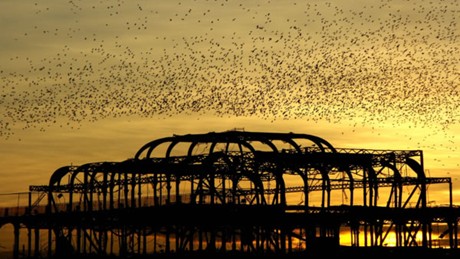The conservation experts behind the annual Birdwatch survey have sung the praises of the spectacular starling displays on Brighton and Hove seafront but warned that their numbers are still falling.
The RSPB (Royal Society for the Protection of Birds) thanked the thousands who took part in the Big Garden Birdwatch – including children from local schools.
Nationwide more than half a million people counted more than eight million birds at the end of January.
And the results, published this morning (Thursday 31 March), include a top ten for Brighton and Hove headed by sparrows and starlings, followed by pigeons.
Blue tits, blackbirds, magpies and robins all made the top ten while gulls – common and herring gulls – were in the top twenty, along with crows, collared doves and wrens.

Pigeons, gulls and sparrows topped the Big Schools Birdwatch results. Across Sussex the top five species were sparrows, starlings, pigeons, blackbirds and blue tits.
| Big Garden Birdwatch – Species in Brighton and Hove | Rank 2016 | Rank 2015 | Rank Change |
| House sparrow | 1 | 1 | 0 |
| Starling | 2 | 2 | 0 |
| Woodpigeon | 3 | 4 | +1 |
| Blue tit | 4 | 6 | +2 |
| Feral pigeon | 5 | 3 | -2 |
| Blackbird | 6 | 7 | +1 |
| Magpie | 7 | 8 | +1 |
| Robin | 8 | 9 | +1 |
| Goldfinch | 9 | 12 | +3 |
| Great tit | 10 | 11 | +1 |
The RSPB said: “Brighton and Hove remains a special space for starlings.”
The charity added: “The mild weather in the months leading up to the 2016 Birdwatch affected bird behaviour, as it provided easy access to bugs and reduced their dependency on garden feeders.”
RSPB conservation scientist Daniel Hayhow said: “The weather can have varied effects on different groups of birds in terms of behaviour and habitats used.
“The increase in smaller garden birds just goes to show that in the absence of very cold weather these species can survive winter in much greater numbers.
“The warmer temperatures have made it easier to find food, like insects, which in colder winters would have been harder to come by because of frosts and snow.”
He said that during periods of colder weather birds struggled to find food in the wider countryside so become more reliant on garden feeders. Smaller birds have adapted to feeding at bird tables or from hanging feeders.
Dr Hayhow said: “Despite this boost in numbers many other of our garden favourites are struggling.
“Sightings of well-known species such as starlings and blackbirds have experienced another drop during the Big Garden Birdwatch this year.
“This decline continues a trend which has seen the number of both species visiting gardens decline by 34 and 19 per cent respectively since 2005.”
| Big Schools Birdwatch – Area | Species | 2016 Rank |
| Brighton and Hove | Feral pigeon | 1 |
| Brighton and Hove | Herring gull | 2 |
| Brighton and Hove | Common gull | 3 |
| Brighton and Hove | House sparrow | 4 |
| Brighton and Hove | Woodpigeon | 5 |
| Brighton and Hove | Black gull | 6 |
| Brighton and Hove | Blackbird | 7 |
| Brighton and Hove | Magpie | 8 |
| Brighton and Hove | Starling | 9 |
| Brighton and Hove | Song thrush | 10 |
Sara Humphrey, from the RSPB South East, said: “A lot of our favourite garden birds are struggling and are in desperate need of our help.
“Starlings continue to be frequent visitors to Brighton and Hove gardens. Residents and tourists are able to watch the spectacular murmurations over the seafront in the winter months but these mesmerising birds are in serious decline.
“Despite holding the second place in the ranking this year, we still saw a 5.5 per cent decline in overall starling visits to local gardens compared to 2015.”
Nationwide the number of starlings spotted has fallen 80 per cent since the survey was first carried out in 1979.
Sara Humphrey added: “Providing food and water in your gardens, outdoor spaces and even on balconies offer invaluable resources for starlings and other garden birds and can have a significant positive effect on local populations.”
The findings of the Big Garden Birdwatch are reflected in the parallel event, Big Schools Birdwatch, which continued to break records with more schools and children taking part than ever.
The UK-wide survey of birds in schools had close to 100,000 school children spending an hour in nature counting birds.
Blackbirds remained the most common playground visitor for the eighth year in a row. The top three was rounded off by black-headed gulls and starlings, with gulls and pigeons recorded as the most popular visitors to Brighton and Hove schools.
Big Garden Birdwatch and Big Schools Birdwatch are a part of the RSPB’s Giving Nature a Home campaign, aimed at tackling the housing crisis facing the UK’s threatened wildlife.
The charity is asking people to provide a place for wildlife in their gardens or outdoor space. This could involve putting up a nest box for birds, creating a pond for frogs or filling outdoor spaces with nectar-rich plants.
For more information, click here.








